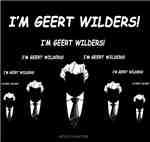In honour of the ongoing political and constitutional crisis at the neighbours herewith a very early vid noir of the unique artist Jacques Brel, who died much too young and whose biography truly fits that illusive multicultural epithet, Belgian.
 Just as there are no Macedonian or European people, the Belgians are the doubtful owners of a non-existent pseudo ethnic label. The tribal Belgae have just as much relation to the present Flemish and Walloons as the ancient tribe of the Teutons have with modern Germany. Here's the historical Wiki of the region through the ages and here's the Wiki for the intricacies of modern Belgium.
Just as there are no Macedonian or European people, the Belgians are the doubtful owners of a non-existent pseudo ethnic label. The tribal Belgae have just as much relation to the present Flemish and Walloons as the ancient tribe of the Teutons have with modern Germany. Here's the historical Wiki of the region through the ages and here's the Wiki for the intricacies of modern Belgium.
The BBC earlier this week made short shrift of the long, complicated story of postmodern Belgian politics. The Brussels Journal has details and suspects the imploded Government was just an EU ploy to get the infamous Lisbon Treaty signed. Now that the document has been ratified, the cabinet served its purpose and has become redundant. We may never know if this conspiracy theory holds a kernel of truth.
However, this might be a good time to acknowledge that the Kingdom of the Belgians is a historical mistake. Belgium, the seat of NATO and the European Union stands model for the EU and is just as synthetic an entity: no nation, but a multicultural state. The sole concept binding them was the originally German royal house of Saxe Coburg, but even they are seen by the Flemish as a bulwark of Francophone dominance.
Going from crisis to crisis is symptomatic of the postmodern propping up of multinational non-nations at the expense of the no longer politically correct sovereign nation-state: multicultural kitch and faux imperial goulash is all the rage.
No democratic nation-state has waged war over the last half a century, but the forces of postmodernism have long made up their mind: nation equals nationalism, equals a machine of war. Belgium may with right be seen as a major battle ground of the postmodern onslaught of transnational progressivism on the old Westphalian guard.
When Flanders was an agricultural backwater Wallonia was an industrial revolution power house. It has run to seed by its inability to adjust to the times, as well as the corruption of its monolithically Socialist politicians. Today the economical shoe is on the other foot: while Wallonia continues to import foreign labour on Socialist principles, poorly educated and under-adjusted Muslims make a bee-line for the ranks of the unemployed, for which Flanders foots the bill. But the squabbles over power and which language group is financially propping up who, are ultimately of secondary importance.
 The Brussels Journal ventures another interesting observation: "Belgium can continue to flourish without a national government for the simple reason that the cabinet doesn’t have to decide much anyway. Most authority has devolved to the regions […] The central government is left to deal with foreign policy, defense and finance policy – all issues that are increasingly taken care of at the EU level."
The Brussels Journal ventures another interesting observation: "Belgium can continue to flourish without a national government for the simple reason that the cabinet doesn’t have to decide much anyway. Most authority has devolved to the regions […] The central government is left to deal with foreign policy, defense and finance policy – all issues that are increasingly taken care of at the EU level."
This accurately describes the transnationalist plan of operation: the national apparatus of state is very gradually stripped of authority and powers, to the point of becoming an empty shell. Once redundant, the 'regions' take over while foreign affairs, defence, and monetary policy is taken care of on the supranational level: curtains for the offensive nation state, hello to the nascent transnational entity consisting of multicultural regions.
The hypothesis is taking shape, that this project was started decades ago on a micro level, when villages, municipalities and town councils were stripped of their historical identity and began a process of re-structuring into administrative clusters under fantasy names that had no root in local history.
An example would be three villages - Oakborough, Bridgewick and Weathertown, administered by the new council of Goodchange (motto: "Change for Progress"). It is preferably well infiltrated by transies, professional key posts being manned by fifth columnists trained by the Common Purpose school of progressive thought. IngSoc exists ...
We'd like to hear your story, if such processes have taken place in your area. Belgium needs careful watching, it being the model for the transnational future.
Back to Brel, Sotheby's just announced an auction of a collection of memorabilia, manuscripts, records, and photos to be held at the Paris office on October 1st. We'll keep you posted.
Till then, enjoy an early performance by a very young Jacques Brel.
Wishing the neighbours all the strength and wisdom they need.
Related:
- "For Flanders"






 - Caption:
- Caption:  - Caption:
- Caption: 



.jpg)




















